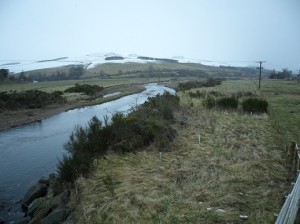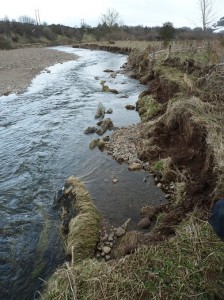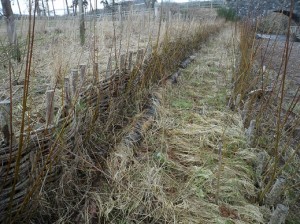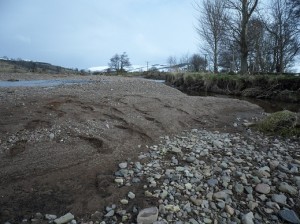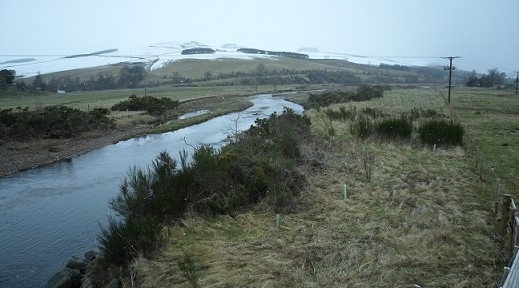
Last Wednesday I had the great opportunity to go down to the Tweed Catchment for a tour of the Natural Flood Management (NFM) measures that had been put in place by the Tweed Forum. The Tweed Forum take an integrated management and planning approach to achieve and promote the sustainable management of the whole river catchment , and are therefore at the forefront of NFM in Scotland.
First up on the day’s schedule was the Bowmont Catchment, which is a wandering gravel river. As the name suggests this river is problematic for landowners, as it constantly moves and changes shape with each high water event. The first NFM measure on the tour was riparian tree planting. Riparian tree planting stabilises the bank, reduces bank erosion risk and provides rigosity to the riparian zone to slow flood water down. Most commonly, native riparian tree species are planted, such as willow and alder.
Continuing on the tour we visited a site that had a novel method of NFM for Scotland put in place, called an apex bar log jam. The idea behind this structure is to create a broad face that captures branches and trees creating the jam at the apex whilst the tail provides an area for sediment deposition creating the bar. Inside the structure three trees are planted, when established these will hold the bar and jam together creating a natural bit of habitat that stabilises the banking and and slows water down. See picture below.
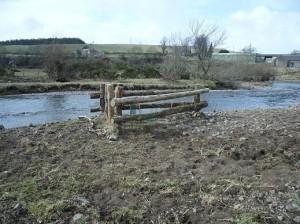
Bar apex log jam on the Bowmont River, notice the branches caught at the apex (head) and gravel deposited at the tail of the structure.
The next set of NFM measures on this tributary, were four different designs and ideas of stopping bank erosion (see picture below).
The first bank erosion protection measure involved entwining logs and steel to make a solid log defence structure that protected a nearby road, and seemed to do its job very well. The second used two tiers of willow spilling holding the bank together (see picture below). I personally like this measure because it is a living structure that will take root into the banking and increase in strength with time. The third measure was Filtrexx which can be hard to spot because it’s a sock filled with compost and seed, and when the seed grows it blends in perfectly as a grassy bank. The last measure was vertical logs which was an idea suggested by a landowner and was probably the least effective over time, as the force of the water wrenched the vertical logs apart using sediment and branches.
The last two sites we visited were in the upland catchment of the Bowmont Catchment and the Gala Water Catchment. The Bowmont Catchment site had an array of NFM measures in place including a hedge row across the hillside to act as a leaky barrier, tree planting on steep slopes and valleys (known as cleuchs in the borders), and apex bar log jams (see picture below). The idea behind all these measures being in the one area is to slow and store as much of the water in the uplands as possible, reducing the flood peak and therefore the risk further downstream.
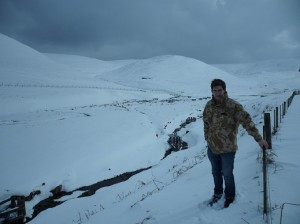
The upper Bowmont Catchment, starting from far left to near right- hedge row planted across the hillside, tree planting in valley/steep slope in the distance, bar apex log jams and me.
The final site of the day, the upper Gala Water Catchment, had a very large area of restored wetland with wetland/riparian tree planting and ponds, and some tree planting on steep slopes (see picture below). This was a fantastic site, despite the snow, that showed effective NFM on a large scale and one which has the storage and slowing capacity that could make a noticeable difference.
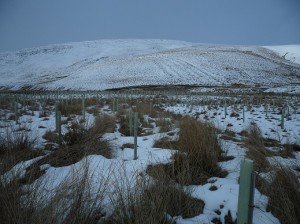
Riparian tree planting/wetland tree planting and re-naturalisation on the upper Gala Water Catchment.
My final image from last week’s visit is of a deposition bar on the Bowmont River that was full of soft, rich and fertile agricultural soil that had been washed away. This image hopefully highlights how important improving land management is so that it becomes sustainable, and how NFM measures play a big role in reducing the occurence of soil sedimentation. Soil sedimentation and run off is harmful to freshwater wildlife, creates bad water quality and is bad for agricultural and land sustainability and productivity.

